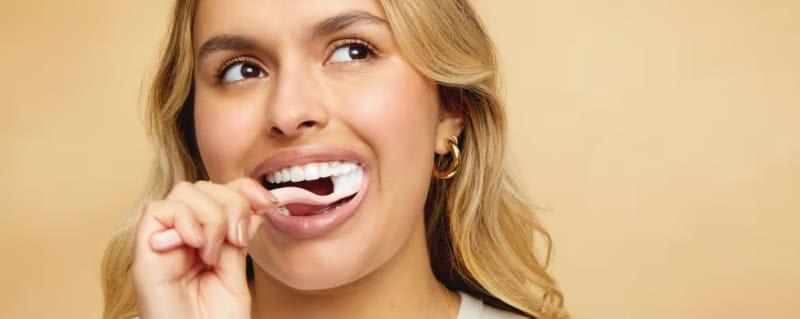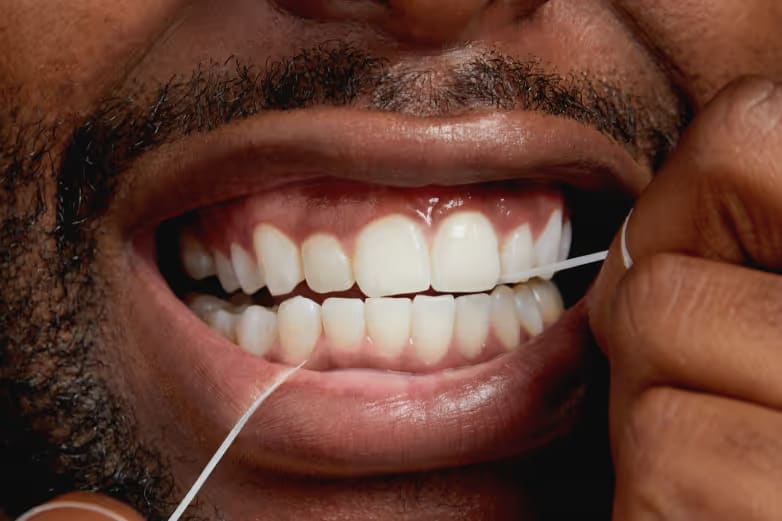Unfortunately, without proper care, braces are vulnerable to plaque buildup and cavities. The good news is it only takes a few extra steps to keep your teeth clean with braces.
Here’s exactly what you’ll need to clean like a professional—and exactly how to do it.

What You Will Need
Soft Toothbrush
Whether you opt for an electric or manual toothbrush, choose a soft-bristled toothbrush to protect your gums and mouth.
Your new braces can lead to tartar build up at your gum line, so it’s especially important to brush well (in circular motions) in that area. Soft bristles will protect your gums from being irritated when you brush. They’ll also maneuver easily around your hardware without damaging it.
Anti-Sensitivity Fluoride Toothpaste
Choosing a fluoride-based toothpaste will ensure the most thorough clean. Anti-sensitivity varieties will also help with any discomfort you may be feeling, especially in your first few weeks with braces.
Oral Irrigator…
An oral irrigator (also known as a water flosser or Waterpik) is an alternative to standard floss that uses a high-powered stream of water to remove plaque and debris from between your teeth. Because flossing around braces can be tricky, many people prefer to use an oral irrigator, which can be maneuvered more easily around brackets and wires.
… or Floss Feeder
If you opt to stick with regular dental floss, a floss feeder (also known as a floss threader) is a must. This handy tool is made of thin plastic with a loop at the end. After putting your floss through the loop, you can easily thread the feeder under the wires of your braces to position the floss.
Interdental Toothbrush or Proxabrush
An interdental toothbrush (also known as a proxabrush) is a small, straight, bristled tool specially designed to reach areas that toothbrushes can miss. Its unique shape makes it especially good at cleaning under braces wires of traditional braces or lingual braces like Tend's Breezy Braces.
Rubber Tipped Gum Massager
A rubber-tipped gum massager—which looks like a metal rod with a pointed rubber tip at the end—can help stimulate the gums and break up and remove plaque at the gumline. Since this area is often harder to reach with braces, the gum massager can be a useful addition.
Tongue Cleaner
Tongue cleaners come in a few basic designs, but they all serve the same function—removing bacteria from your tongue. Tongue bacteria can easily spread to your new braces, so it’s a good idea to get rid of it with a tongue cleaner. (Bonus: it also helps prevent bad breath!)
How to Clean Your Teeth with Braces
Now that you’ve got the right tools, here’s how to keep that new smile clean.
1. Remember to Brush After Every Meal
You’ve probably heard this one before, but now that you have braces, it’s more important than ever. Food particles and debris can (and will!) get caught in your braces during meals. Brushing immediately afterwards is the best way to ensure your braces stay clean and your teeth stay protected.
Bonus tip: if you wear clear aligners (like Invisalign), you need to brush after every meal, too! Always reinsert your aligners into a clean mouth.
2. Go Easy on The Toothpaste
Believe it or not, less is more when it comes to toothpaste and braces. The foam created by toothpaste can make it hard to see any debris stuck in your braces. A pea-sized amount is just right.
3. Don’t Brush Too Hard
Your braces are strong and sturdy—so are your teeth! Even so, be careful not to use too much pressure while you brush. While it’s unlikely that brushing too hard will damage your braces, it can nonetheless lead to problems like recessed gums, tooth sensitivity, and even loose teeth.
4. Spend 30 Seconds Brushing Each Quarter of Your Mouth (2 Minutes Total Brushing Time)
To start, divide your mouth into four “quarters,” or “quadrants”: top right, top left, bottom right, and bottom left. Each quadrant starts at the center tooth and extends to the back molar.
Then, spend about 30 seconds carefully brushing each quadrant. Many electric toothbrushes have built-in timers you can use; if not, feel free to use your own timer.
Holding your toothbrush at a 45-degree angle, gently maneuver it to brush along the gumline, both sides of the brackets, and the ends of your teeth. Then clean the chewing surfaces and the opposite sides. When your 30 seconds are up, move on to the next quadrant.
5. Pay Special Attention to the Area In Between the Brackets and Your Gums
Braces can lead to tartar buildup around your gum line, primarily because it’s difficult to clean the area between the brackets and the gums. Keep your toothbrush at a 45 degree angle and focus on gently brushing in this area at the start of your 30 seconds in each “quadrant.”
6. Use a Proxabrush to Clean Those Hard to Reach Places
After your two minutes are up, gently insert your proxabrush underneath your braces wires and in any tight crevices between teeth to dislodge any remaining debris. (No need to use toothpaste on your proxabrush.)

7. Don’t Forget to Floss!
Regular flossing is just as essential as brushing, especially when you have braces. Although it can be tricky to floss with braces, a floss threader can help you maneuver around the wires and make it easier to incorporate into your daily oral hygiene routine.
Carefully thread the floss under the main wire, then pull it through. Wrap the ends around your fingers and slide the floss between your teeth. Take your time moving it towards the gumline, and stop before you feel any pain. You can use any floss you’d like, although waxed floss is often easier to slide in tight spaces.
To remove, grab one end of the floss and pull the strand out.
8. Use an Antiseptic Mouthwash at Bedtime
An antiseptic fluoride mouthwash is a great last step after flossing and brushing. Swish for about a minute to help clear out any remaining debris.
Tips for Cleaning Clear Aligners
If you have clear aligners, you’ll also need to take the steps to keep them clean.
Most toothpastes are too abrasive for aligners; instead, rinse them at night and scrub them with a toothbrush and a mild liquid soap. You can also soak them in a denture solution or a specialty cleaning solution like Invisalign’s cleaning crystals.
After soaking or cleaning, let your aligners air dry on the counter for 15-30 minutes, then return them to their protective case.
Always remember to brush your teeth after eating if you wear clear aligners, before reinserting them. Not doing so can trap bacteria under your aligners, which can damage them and lead to plaque and cavities.
Learn more about caring for your clear aligners.
Other helpful dental tools
Rubber Tipped Gum Massager
A rubber-tipped gum massager can be a good addition to your oral care routine if you wear braces. To use, simply hold the rubber tip under warm running water to loosen it up, then run it gently along your gum line. This will help dislodge any leftover plaque or debris near your gums. Be sure to rinse your mouth afterwards.
Tongue Cleaner
Tongue cleaners come in a few different designs, but most are used the same way.
You’ll start by sticking your tongue out as far as is comfortable. Then, gently scrape the tongue cleaner along your tongue from back to front. Rinse the cleaner, and repeat if you’d like. Be sure to concentrate on the back of your tongue, where bacteria builds up most easily. (But only go as far back as is comfortable!) Rinse your mouth out afterwards.
FAQs About Cleaning Your Teeth with Braces
-
Can you get your teeth cleaned while wearing braces?
You can and should get your teeth cleaned by a hygienist while wearing braces! Getting regular cleanings is one of the most important ways to keep your teeth in top shape while you’re wearing braces.
-
How do you clean under braces?
Use a soft-bristled toothbrush at a 45-degree angle to gently clean the tops and bottoms of your brackets and under your wires. For particularly tricky spots, gently insert a proxabrush to dislodge any stuck food or debris.
-
How often should you brush your teeth if you wear braces?
If you wear braces, you should brush morning and evening, plus after every meal. This small commitment to oral care will go a long way to keeping your mouth healthy. You’ve already invested so much in your new smile—now’s the time to protect that investment.
Ready to take the first step to a straighter smile?
Book a free consult with one of our top-rated dentists to learn more about Tend's Breezy Braces®
Book Now